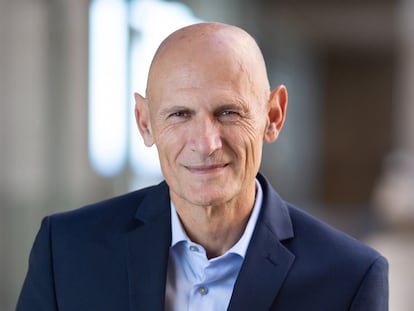A basement full of worms could shed some light on the secrets of aging
The ‘lifespan machine’ scans tens of thousands of identical animals every hour in an attempt to understand why some live much longer than others

Not far from the popular Barceloneta beach in Barcelona, Spain, an underground room houses 35 office scanners stored in refrigerated chambers. Nicholas Stroustrup, an American biologist, is the holder of the key to the door of this peculiar place that is flooded by the roar of a very powerful air conditioner. “This is the lifespan machine!” he shouts so he can be heard over the noise. The scientist carefully opens the lid of one of the scanning devices. Inside, there are hundreds of worms. Hundreds more appear under another lid. He estimates that there are more than 20,000 worms in the room. The youngest ones keep moving: restlessly, they explore their environment. It is easy to feel dizzy when looking through the microscope at the oldest, motionless and wrinkled, waiting for death. This unusual machine, claims Stroustrup, could reveal the secrets of aging in human beings.
The scientist shares a surprising reflection: there is a lot of randomness in aging which has nothing to do with genetics – a person can die at 60 years of age, while their identical twin reaches 90. His worms, he explains, are not that different from humans. They are tiny animals, barely a millimeter long, with a ridiculous and exact number of cells: 959, no more, no less, apart from the ovules and sperms. A person is made up of about 30 trillion cells. However, despite their tiny size, these worms have everything: a mouth, an anus, a nervous system with 302 neurons, skin, genes, muscles.
The biologist, who compares aging to the game of roulette, is trying to discover its enigmatic rules. His lifespan machine scans the worms every hour, from birth to death. They usually live about 18 days, but the scientists perform all kinds of experiments to see what happens: they change their diet, stress them out, drug them, modify their genes, expose them to pathogens, raise or lower their temperature. Stroustrup thinks back. He has worked with “millions” of worms, and remembers some that lived for 50 days, the equivalent of a person reaching 225 years. Why did they live for so long while their identical siblings didn’t? They do not know.
Stroustrup came up with the idea for the lifespan machine when he was a 22-year-old doctoral student at Harvard University. Lacking the money for fancy automated microscopes, he went to a store and bought an ordinary office scanner. The first time he scanned a worm, he was amazed at the resolution. With a meager investment he was able to study tens of thousands of animals at once.
His first results were published in the journal Nature in 2016, and the data were surprising. A multitude of groups of identical worms lived more or less in each experiment, but there was always a pattern: within the same group, some lived longer than others. There was a constant randomness in the aging process. Stroustrup’s team has now gone further, investigating another factor besides longevity: how long the worms maintain vigorous movement.
The intuitive idea is that animals, as well as humans, have a biological age that could be different, or not, from their real age. A person may be 70 years old based on their date of birth, but their cells could be more like 55. Stroustrup’s experiment suggests something else that is quite different. The worms that maintain vigorous movement for longer – a reflection of healthy living – also live longer. However, statistical differences indicate that they are two independent variables. His study, published recently in the specialized journal PLOS Computational Biology, states that worms have at least two biological ages: one that determines the end of vigorous movement and another that marks the moment of death. Stroustrup suspects that there is actually a “constellation” of biological ages, depending on what part of the body is seen.
Can the longevity of a worm really reveal the keys to human aging? Sarcastically, Stroustrup replies with another question: “Can aging research in humans themselves reveal the secrets of human aging?” Repeating his experiments on people, he argues, would take decades. Centuries, even. The current focus is to look for other variables that are strongly correlated with aging, like the so-called epigenetic clock, chemical marks on DNA that are used to measure biological age. If a drug that is administered to a person has an effect on this epigenetic clock, it could be assumed that there will also be an effect on aging, but it would take decades to confirm this. Stroustrup’s new study suggests it is not that simple. If there are multiple biological ages, one of these indicators may suggest greater youth, while another denotes old age. Many companies already sell these controversial tests to measure biological age.
The worms that Stroustrup uses belong to the species Caenorhabditis elegans, already the center of experiments that have won three Nobel prizes: two for Medicine (2002 and 2006) and one for Chemistry (2008). The first one was for Sydney Brenner, the South African biologist who in the 1960s researched the function of DNA in these worms. “Genetics is the master science of biology. In fact, it’s the only science and all the others are ways of getting to understand what the genes do,” Brenner stated in his memoirs. In Stroustrup’s lab, Indian biotechnologist Natasha Oswal and Spanish neuroscientist Andrea del Carmen inactivate worm genes in the Barcelona basement. Del Carmen points out that other laboratories have managed to make their worms live 10 times longer with a single mutation. “Longevity is very malleable,” she emphasizes.
Biochemist Carlos López Otín, an expert in aging at the University of Oviedo, points out that Stroustrup’s new experiment shows “a negative correlation” between the period of vigorous movement of the worms and the duration of the subsequent period. “In other words, animals with a long healthy life would be doubly lucky, living a shorter phase of final functional decline,” he says. López Otín – who did not participate in this study – warns that more research is needed on the molecular mechanisms involved to confirm that the results in worms can be extrapolated to humans.
Italian hematologist Carolina Florian applauds the new work, and stresses that aging is a highly complex process. “Not everybody ages at the same rate, and the cells and tissues of our body can even age at different rates,” explains Florian, from the Bellvitge Biomedical Research Institute, in Hospitalet de Llobregat (Barcelona). “Given the complexity of aging, and the difficulties to even precisely define when a cell, tissue or organism is old, it is very easy to run into confounding factors,” she continues. “Precisely for this reason, this study in worms has really important implications for our current understanding of how biomarkers can predict human aging.”
Florian encourages the scientific community to keep going and develop innovative experiments that reveal the true mechanisms of aging. “We are already fully aware that aging is a biological process and that it is possible to treat it in order to extend the duration of life.”
Tu suscripción se está usando en otro dispositivo
¿Quieres añadir otro usuario a tu suscripción?
Si continúas leyendo en este dispositivo, no se podrá leer en el otro.
FlechaTu suscripción se está usando en otro dispositivo y solo puedes acceder a EL PAÍS desde un dispositivo a la vez.
Si quieres compartir tu cuenta, cambia tu suscripción a la modalidad Premium, así podrás añadir otro usuario. Cada uno accederá con su propia cuenta de email, lo que os permitirá personalizar vuestra experiencia en EL PAÍS.
¿Tienes una suscripción de empresa? Accede aquí para contratar más cuentas.
En el caso de no saber quién está usando tu cuenta, te recomendamos cambiar tu contraseña aquí.
Si decides continuar compartiendo tu cuenta, este mensaje se mostrará en tu dispositivo y en el de la otra persona que está usando tu cuenta de forma indefinida, afectando a tu experiencia de lectura. Puedes consultar aquí los términos y condiciones de la suscripción digital.
More information
Últimas noticias
The late consecration of women artists in their 90s
The Florida Keys tourist paradise is besieged by immigration agents: ‘We’ve never seen anything like this’
The latest scam on WhatsApp behind the legal dream: using immigration status as bait
Oil, gold and rare earth elements: the backdrop to US political tension with Venezuela
Most viewed
- Families demand repatriation of bodies of Colombians who died in Ukraine: ‘This war is a slaughterhouse for foreigners’
- The low-cost creative revolution: How technology is making art accessible to everyone
- Liset Menéndez de la Prida, neuroscientist: ‘It’s not normal to constantly seek pleasure; it’s important to be bored, to be calm’
- Christian Louboutin: ‘Young people don’t want to be like their parents. And if their parents wear sneakers, they’re going to look for something else’
- ‘El Limones’ and the growing union disguise of Mexican organized crime










































